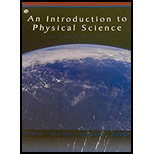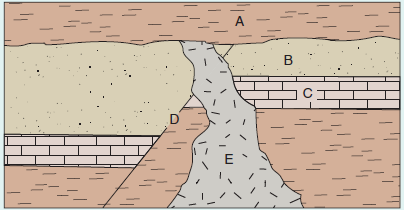
INTRO.TO PHYSICAL SCIENCE NSU PKG >IC<
14th Edition
ISBN: 9781305765443
Author: Shipman
Publisher: CENGAGE C
expand_more
expand_more
format_list_bulleted
Concept explainers
Textbook Question
Chapter 24, Problem 3E

Figure 24.21 Relative Dating See Exercises 3 and 4.
3. Refer to ● Fig. 24.21.
- (a) Which rock stratum is younger, A or C? What geologic principle did you use?
- (b) Which is younger, the rock stratum marked C or the igneous intrusion marked E? What geologic principle did you use?
Expert Solution & Answer
Trending nowThis is a popular solution!

Students have asked these similar questions
A beam of alpha-particles of energy 7.3MeV is used.The protons emitted at an angle of zero degree are found to have energy of 9.34MeV.Find the Q-value of this reaction .
An aluminum rod and a copper rod have the same length of 100cm at 5C. At what temperatures would one of the rods be 0.5 mm longer than the other? Which rod is longer at such temperature?
ROTATIONAL DYNAMICS
Question 01
A solid circular cylinder and a solid spherical ball of the same mass and radius are rolling
together down the same inclined. Calculate the ratio of their kinetic energy. Assume pure
rolling motion Question 02
A sphere and cylinder of the same mass and radius start from ret at the same point and more
down the same plane inclined at 30° to the horizontal
Which body gets the bottom first and what is its acceleration
b) What angle of inclination of the plane is needed to give the slower body the same
acceleration
Question 03
i)
Define the angular velocity of a rotating body and give its SI unit
A car wheel has its angular velocity changing from 2rads to 30 rads
seconds. If the radius of the wheel is 400mm. calculate
ii)
The angular acceleration
iii)
The tangential linear acceleration of a point on the rim of the wheel
Question 04
in 20
Chapter 24 Solutions
INTRO.TO PHYSICAL SCIENCE NSU PKG >IC<
Ch. 24.1 - Are dinosaur footprints fossils?Ch. 24.1 - Prob. 2PQCh. 24.2 - Prob. 1PQCh. 24.2 - Prob. 2PQCh. 24.2 - Prob. 24.1CECh. 24.2 - Prob. 24.2CECh. 24.3 - Prob. 1PQCh. 24.3 - Prob. 2PQCh. 24.3 - Prob. 24.3CECh. 24.4 - Prob. 1PQ
Ch. 24.4 - Prob. 2PQCh. 24.5 - Prob. 1PQCh. 24.5 - Prob. 2PQCh. 24.5 - Prob. 24.4CECh. 24 - KEY TERMS 1. geologic time (Intro) 2. fossil...Ch. 24 - KEY TERMS 1. geologic time (Intro) 2. fossil...Ch. 24 - Prob. CMCh. 24 - Prob. DMCh. 24 - Prob. EMCh. 24 - Prob. FMCh. 24 - Prob. GMCh. 24 - Prob. HMCh. 24 - Prob. IMCh. 24 - Prob. JMCh. 24 - Prob. KMCh. 24 - Prob. LMCh. 24 - Prob. MMCh. 24 - Prob. NMCh. 24 - Prob. OMCh. 24 - Prob. PMCh. 24 - Prob. QMCh. 24 - Prob. RMCh. 24 - Prob. SMCh. 24 - Prob. TMCh. 24 - Prob. UMCh. 24 - Prob. VMCh. 24 - Prob. WMCh. 24 - Prob. XMCh. 24 - Prob. ZMCh. 24 - Prob. 1MCCh. 24 - Prob. 2MCCh. 24 - Prob. 3MCCh. 24 - What is the name for the type of fossil formed...Ch. 24 - Prob. 5MCCh. 24 - What is obtained when rocks and geologic events...Ch. 24 - Prob. 7MCCh. 24 - Prob. 8MCCh. 24 - Prob. 9MCCh. 24 - Prob. 10MCCh. 24 - If the half-life of a radioactive specimen is 100...Ch. 24 - Prob. 12MCCh. 24 - Prob. 13MCCh. 24 - Prob. 14MCCh. 24 - Prob. 15MCCh. 24 - Prob. 16MCCh. 24 - Prob. 17MCCh. 24 - Prob. 18MCCh. 24 - Prob. 19MCCh. 24 - Prob. 20MCCh. 24 - Prob. 1FIBCh. 24 - Prob. 2FIBCh. 24 - Prob. 3FIBCh. 24 - Prob. 4FIBCh. 24 - Prob. 5FIBCh. 24 - Prob. 6FIBCh. 24 - Prob. 7FIBCh. 24 - Prob. 8FIBCh. 24 - Prob. 9FIBCh. 24 - Prob. 10FIBCh. 24 - Prob. 11FIBCh. 24 - Prob. 12FIBCh. 24 - Prob. 13FIBCh. 24 - Prob. 14FIBCh. 24 - Prob. 15FIBCh. 24 - Prob. 16FIBCh. 24 - Prob. 17FIBCh. 24 - Prob. 18FIBCh. 24 - Prob. 19FIBCh. 24 - Prob. 20FIBCh. 24 - What is meant by the phrase geologic time?Ch. 24 - Why are so few fossils of worms found?Ch. 24 - Prob. 3SACh. 24 - Prob. 4SACh. 24 - Prob. 5SACh. 24 - Prob. 6SACh. 24 - Prob. 7SACh. 24 - Prob. 8SACh. 24 - How do fossils aid in oil exploration?Ch. 24 - Prob. 10SACh. 24 - How might the principle of superposition be...Ch. 24 - Prob. 12SACh. 24 - Prob. 13SACh. 24 - Prob. 14SACh. 24 - Prob. 15SACh. 24 - Prob. 16SACh. 24 - What four features characterize the best index...Ch. 24 - Prob. 18SACh. 24 - Prob. 19SACh. 24 - Prob. 20SACh. 24 - Prob. 21SACh. 24 - Prob. 22SACh. 24 - Prob. 23SACh. 24 - Prob. 24SACh. 24 - Prob. 25SACh. 24 - Prob. 26SACh. 24 - Carbon-14 dating measures the ratio of carbon-14...Ch. 24 - What are the three conditions for using an isotope...Ch. 24 - Distinguish between primordial lead and radiogenic...Ch. 24 - Prob. 30SACh. 24 - Prob. 31SACh. 24 - Prob. 32SACh. 24 - Prob. 33SACh. 24 - Prob. 34SACh. 24 - Prob. 35SACh. 24 - Prob. 36SACh. 24 - Prob. 37SACh. 24 - Prob. 38SACh. 24 - What biologic event is used by geologists to...Ch. 24 - What is the biological event that started the...Ch. 24 - Prob. 41SACh. 24 - Prob. 42SACh. 24 - Prob. 43SACh. 24 - In what period and era were the great coal-forming...Ch. 24 - About how many days on the geologic time calendar...Ch. 24 - Prob. 1VCCh. 24 - What are the strengths and weaknesses of the...Ch. 24 - Prob. 2AYKCh. 24 - Prob. 3AYKCh. 24 - Prob. 4AYKCh. 24 - Prob. 5AYKCh. 24 - Prob. 1ECh. 24 - Prob. 2ECh. 24 - Figure 24.21 Relative Dating See Exercises 3 and...Ch. 24 - Figure 24.21 Relative Dating See Exercises 3 and...Ch. 24 - Metamorphic rock shows that only 25% of its...Ch. 24 - Prob. 6ECh. 24 - Prob. 7ECh. 24 - Suppose that one species of index fossil lived...
Knowledge Booster
Learn more about
Need a deep-dive on the concept behind this application? Look no further. Learn more about this topic, physics and related others by exploring similar questions and additional content below.Similar questions
- Question B3 Consider the following FLRW spacetime: t2 ds² = -dt² + (dx² + dy²+ dz²), t2 where t is a constant. a) State whether this universe is spatially open, closed or flat. [2 marks] b) Determine the Hubble factor H(t), and represent it in a (roughly drawn) plot as a function of time t, starting at t = 0. [3 marks] c) Taking galaxy A to be located at (x, y, z) = (0,0,0), determine the proper distance to galaxy B located at (x, y, z) = (L, 0, 0). Determine the recessional velocity of galaxy B with respect to galaxy A. d) The Friedmann equations are 2 k 8πG а 4πG + a² (p+3p). 3 a 3 [5 marks] Use these equations to determine the energy density p(t) and the pressure p(t) for the FLRW spacetime specified at the top of the page. [5 marks] e) Given the result of question B3.d, state whether the FLRW universe in question is (i) radiation-dominated, (ii) matter-dominated, (iii) cosmological-constant-dominated, or (iv) none of the previous. Justify your answer. f) [5 marks] A conformally…arrow_forwardSECTION B Answer ONLY TWO questions in Section B [Expect to use one single-sided A4 page for each Section-B sub question.] Question B1 Consider the line element where w is a constant. ds²=-dt²+e2wt dx², a) Determine the components of the metric and of the inverse metric. [2 marks] b) Determine the Christoffel symbols. [See the Appendix of this document.] [10 marks] c) Write down the geodesic equations. [5 marks] d) Show that e2wt it is a constant of geodesic motion. [4 marks] e) Solve the geodesic equations for null geodesics. [4 marks]arrow_forwardPage 2 SECTION A Answer ALL questions in Section A [Expect to use one single-sided A4 page for each Section-A sub question.] Question A1 SPA6308 (2024) Consider Minkowski spacetime in Cartesian coordinates th = (t, x, y, z), such that ds² = dt² + dx² + dy² + dz². (a) Consider the vector with components V" = (1,-1,0,0). Determine V and V. V. (b) Consider now the coordinate system x' (u, v, y, z) such that u =t-x, v=t+x. [2 marks] Write down the line element, the metric, the Christoffel symbols and the Riemann curvature tensor in the new coordinates. [See the Appendix of this document.] [5 marks] (c) Determine V", that is, write the object in question A1.a in the coordinate system x'. Verify explicitly that V. V is invariant under the coordinate transformation. Question A2 [5 marks] Suppose that A, is a covector field, and consider the object Fv=AAμ. (a) Show explicitly that F is a tensor, that is, show that it transforms appropriately under a coordinate transformation. [5 marks] (b)…arrow_forward
- No chatgpt pls will upvote Iarrow_forwardHow would partial obstruction of an air intake port of an air-entrainment mask effect FiO2 and flow?arrow_forward14 Z In figure, a closed surface with q=b= 0.4m/ C = 0.6m if the left edge of the closed surface at position X=a, if E is non-uniform and is given by € = (3 + 2x²) ŷ N/C, calculate the (3+2x²) net electric flux leaving the closed surface.arrow_forward
- No chatgpt pls will upvotearrow_forwardsuggest a reason ultrasound cleaning is better than cleaning by hand?arrow_forwardCheckpoint 4 The figure shows four orientations of an electric di- pole in an external electric field. Rank the orienta- tions according to (a) the magnitude of the torque on the dipole and (b) the potential energy of the di- pole, greatest first. (1) (2) E (4)arrow_forward
arrow_back_ios
SEE MORE QUESTIONS
arrow_forward_ios
Recommended textbooks for you
 An Introduction to Physical SciencePhysicsISBN:9781305079137Author:James Shipman, Jerry D. Wilson, Charles A. Higgins, Omar TorresPublisher:Cengage Learning
An Introduction to Physical SciencePhysicsISBN:9781305079137Author:James Shipman, Jerry D. Wilson, Charles A. Higgins, Omar TorresPublisher:Cengage Learning AstronomyPhysicsISBN:9781938168284Author:Andrew Fraknoi; David Morrison; Sidney C. WolffPublisher:OpenStax
AstronomyPhysicsISBN:9781938168284Author:Andrew Fraknoi; David Morrison; Sidney C. WolffPublisher:OpenStax

An Introduction to Physical Science
Physics
ISBN:9781305079137
Author:James Shipman, Jerry D. Wilson, Charles A. Higgins, Omar Torres
Publisher:Cengage Learning

Astronomy
Physics
ISBN:9781938168284
Author:Andrew Fraknoi; David Morrison; Sidney C. Wolff
Publisher:OpenStax
General Relativity: The Curvature of Spacetime; Author: Professor Dave Explains;https://www.youtube.com/watch?v=R7V3koyL7Mc;License: Standard YouTube License, CC-BY